We've had a more-or-less normal 24 hours in January, with temperatures between -1°C and -11°C—bog standard.
That said, we've also had the latest sub-freezing high temperature ever (January 1st), which ended the longest-ever stretch without sub-freezing high temperatures (310 days); the second-most days in a calendar year without a sub-freezing high temperature (354); and the fourth-longest stretch without 25 mm of cumulative snow (through January 5th). More records: the longest period ever without a 25 mm snowfall (325 days, still going); the longest period ever with less than 25 mm of snow on the ground (323 days, still going); and by Thursday, given the forecast, the latest-ever 25 mm-or-greater snowfall (last broken on 17 January 1899).
Meanwhile, it snowed in Jerusalem last week, an event as common as...well, snow in Los Angeles.
Now, with more extreme weather in more places, the *New!* *Improved!* Anthropogenic Climate Change! Yay!
Cartoonist Scott Adams did not like Les Misérables:
In a pivotal scene in Les Misérables, one of the main characters finds himself in a sewer, up to his nostrils in human waste, with a bullet in his torso, while being pursued by the authorities who have just killed all of his friends. This was my favorite scene in Les Misérables because I could relate to it. Watching that f[...]g movie feels exactly like being up to your nostrils in human waste, with a bullet in your torso, after the government has killed all of your friends. The main difference is that the movie is longer. Much, much longer.
Anne Hathaway played the part of a whining, mud-caked, Halloween skeleton who blamed the system for her problems. Typical liberal. Hugh Jackman played Wolverine, I think. I didn't catch a lot of the details because it's the sort of movie that makes your mind try to crawl out of your ear hole in search of anything that isn't the movie.
Oh, to have a peek at his in-box today...
James Fallows has distilled the discussion about the debt ceiling to two sentences:
Here they are:
- Raising the debt ceiling does not authorize one single penny in additional public spending.
- For Congress to "decide whether" to raise the debt ceiling, for programs and tax rates it has already voted into law, makes exactly as much sense as it would for a family to "decide whether" to pay a credit-card bill for goods it has already bought.
That is all.
Oh, how I really wish that were the end of it. But the Republicans in Congress, having long ago banished Rhyme and Reason to the Castle in the Air, seem determined once again to fight it once again.
It's 12°C in Chicago right now, a temperature perfectly normal for April 1st, and 12.2°C above normal for January 13th.
This week's spring-like temperatures and the medium-term climate forecast make it likely that January 2013 will be the 335th consecutive month of above-normal temperatures. That means, if you're under 28 years old and lived in the U.S., you have never experienced a normal month.
Sadly, tonight things get back to normal:
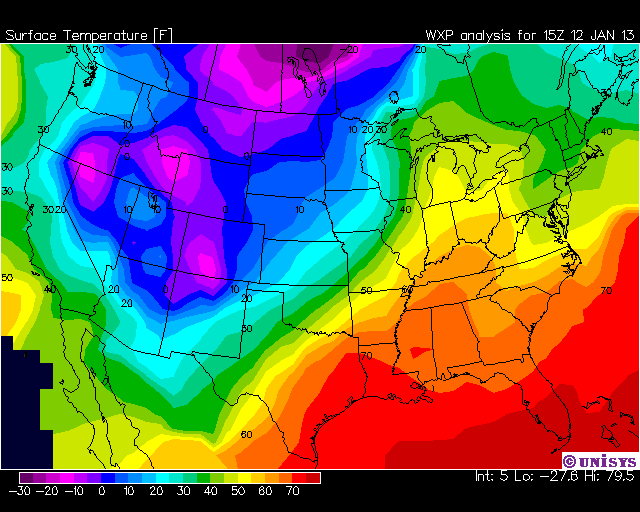
Here's the forecast graph:

Boy, I can't wait for the freezing rain and sleet coming in 15 hours.
Via TPM, the White House has responded to the petition to build a Death Star:
This Isn't the Petition Response You're Looking For
The Administration shares your desire for job creation and a strong national defense, but a Death Star isn't on the horizon. Here are a few reasons:
- The construction of the Death Star has been estimated to cost more than $850,000,000,000,000,000. We're working hard to reduce the deficit, not expand it.
- The Administration does not support blowing up planets.
- Why would we spend countless taxpayer dollars on a Death Star with a fundamental flaw that can be exploited by a one-man starship?
Perhaps the previous administration would have been more amenable?
How many of you have seen this floating around the Intertubes?
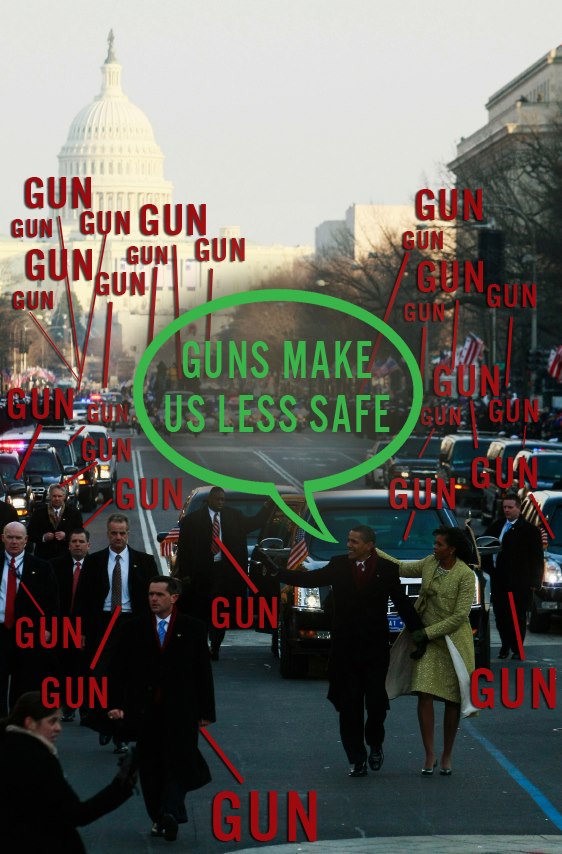
This purports to show how guns make us safer by depicting the President of the United States walking down Pennsylvania Avenue, flanked by the Secret Service and the D.C. Police, all of whom were armed with guns. The implicit argument is that the President is safer because he's surrounded by all those concealed firearms.
I'm kind of busy today, so I don't have time to examine all of the ways that the argument makes no sense, but here are the highlights:
- From what, exactly, are these police and agents protecting the President? Could it possibly be: guns?
- Does anyone seriously doubt that having dozens of armed bodyguards might make anyone safer? (Unless, for example, you can't trust your bodyguards.)
- Does it matter that the President is a hugely-valuable military and political target whose assassination could jeopardize the interests of the United States (not to mention millions of lives), and therefore is especially vulnerable to gun violence without his guards?
- Did the presence of armed bodyguards prevent people from shooting at presidents Reagan, Ford, Kennedy, Franklin Roosevelt, Teddy Roosevelt, McKinley, Garfield, Lincoln, or Jackson?
- Could the presence of millions of guns make an attempt on someone's life more likely in the U.S. than elsewhere?
- Continuing the thought, the United Kingdom's Prime Minister is similarly a high-value target, but...well, here is the PM and deputy PM walking down Whitehall in broad daylight with, it appears, a single armed guard (who's staying discretely back from the ministers):
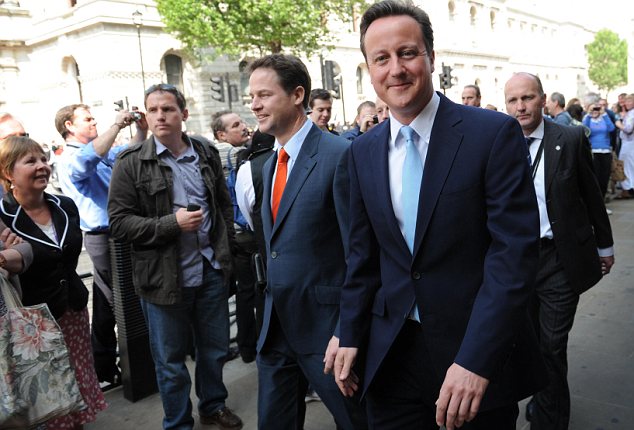
Even better, here's David Cameron walking to Parliament surrounded by random tourists:
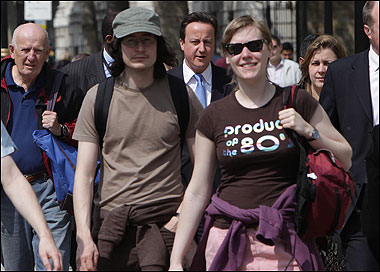
Now, you have to remember, the Prime Minister's residence has actually been shelled, from a mortar emplacement right in front of the Ministry of Defence. So why isn't the UK's political leader at all worried when he walks down Whitehall?
Pointing to the President's bodyguards and saying we're all safer when armed is like pointing to David Vetter and saying we're all safer from disease when in a sterile environment. (I'm sure some gun nut will say "guns are like antibodies." That only shows the problems with similes.)
I'm sure I'll come back to this. I will leave you with this photo of another head of government, Canada's Stephen Harper, surrounded by complete strangers at a public event with no visible security (though I'm sure he had at least one Mountie guarding him):

As Chicago today goes through its record 321st day without a 25 mm snowfall on its way to 13°C temperatures this weekend, we can take some comfort knowing that this summer's weather in Australia has been unimaginably worse:
Heat is part of the national mythology. It killed some of the country’s first white explorers, and has sparked many devastating fires. The worst, “Black Saturday” in Victoria, killed 173 people four years ago. Thanks to better preparation, firefighting skills and a good dose of luck, fires raging in four states in the latest heatwave have spared humans. Yet Australia is getting ever hotter. The 2013 heatwave has set a new record, 40.3°C, for the highest national average temperature. So far, Leonora, a town in Western Australia, has been the hottest place of all, at 49°C on January 9th. That is still below the highest temperature ever recorded in Australia, 50.7°C at Oodnadatta 53 years ago.
The punchline: the Australian weather service has added colors to its map to account for the heat:
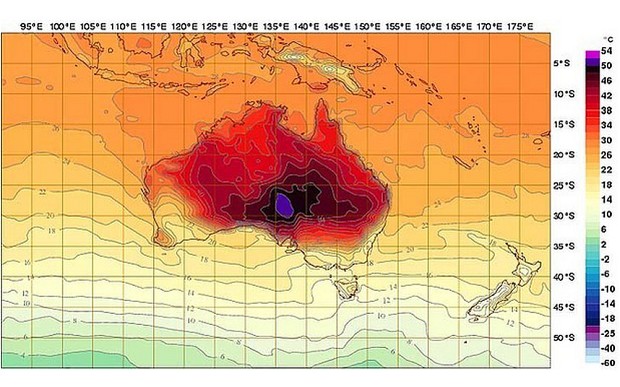
The scorching conditions are set to continue into the coming week and prompted the national Bureau of Meteorology to take the extraordinary measure of revamping its weather charts. New colours have been added to forecasting maps — deep purple and pink — to mark out areas experiencing peaks above 50°C.
The colours have come in for immediate use, with large purple blotches appearing on the weather map for next Sunday and Monday. Temperatures in parts of the state of South Australia are tipped to exceed 50°C.
But hey, New Zealand looks perfectly comfortable on that map...
My efforts to move Weather Now up to Microsoft Azure took on some new urgency today when I noticed this:

That particular error code means the RAID battery has less than 24 hours of charge in it. Fortunately, this means only that the disk will slow down if the battery dies, unless there's a sudden power failure, in which case I could lose the entire RAID volume.
This is exactly the sort of thing that made me want to move all my applications to the Cloud in the first place.
I just hope I can finish the port before...well, before ol' Sparky dies...
Ah, Illinois. I got so excited that we could become the 10th state to formalize marriage equality this week, even as I knew we'd probably not solve our pension problems in one go. Nope:
The gay marriage bill seemed unlikely to make it to a final vote during the waning hours of the Illinois legislature's lame-duck session which ended Tuesday. And with a new legislature about to be sworn in, one sure local vote for the measure will be lost as Skip Saviano, a Republican from Elmwood Park, leaves Springfield after an election loss.
Three other local legislators will continue in the new session and have pledged their support of the Religious Freedom and Marriage Fairness Act. State Sen. Don Harmon and State Reps LaShawn Ford and Camille Lilly will back the bill according to a gay rights advocacy organization. State Rep. Kimberly Lightford reportedly remains undecided on the issue.
The Tribune is livid:
On Tuesday, as their lame-duck session became their dead-duck session, the Illinois General Assembly made it official: House Speaker Michael Madigan, Senate President John Cullerton and their Democratic majorities want you to know they simply are not capable of agreeing on any law that would begin to fix their terrible pension debacle. Nor do Gov. Pat Quinn, Senate Minority Leader Christine Radogno or House Minority Leader Tom Cross have the means to compel them.
So as the state's unfunded pension liability of $96.8 billion rises by some $17.1 million a day, Tuesday's $17.1 million was especially exasperating. Exasperating, that is, for everyone but Squeezy the Pension Python, the mythical creature Quinn's office begat in order to illustrate how pension costs are squeezing the lifeblood out of state government's other missions.
Tuesday was the last in a series of days when lawmakers of both parties could have bucked the public employees unions that dictate so much of state government's policy and spending decisions.
("Squeezy the Pension Python?" At least this governor, unlike his two immediate predecessors, isn't a criminal.)
Anyway, at some point, Illinois' pension system will just collapse, because no one involved is willing to save it. As Tom Lehrer said, "I'm beginning to feel like a Christian Scientist with appendicitis."
There's a meme going around the gun-rights folks right now that banning assault weapons won't keep people from killing each other. Think of the thousands of people stabbed to death every year! Just look at this graphic:
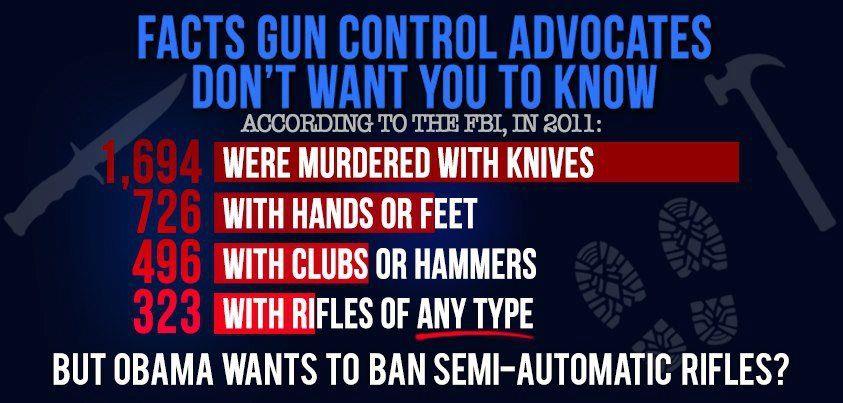
While their specific numbers are wrong, the basic assertion is correct: Very few people get killed by rifles in the U.S. No, our eye-watering murder rate comes mainly from handguns, which are second only to cars in the league table of man-made health risks in the U.S.
Start with the raw numbers. There were 14,612 murders in the U.S. in 2011, of which about 11,500 were by guns. That gives us a homicide rate around 5 per 100,000 population. (Source: FBI)
Compare that with the 39 gun murders in the UK, out of their total 550, for roughly the same period. That's a rate of 1.4 murders per 100,000, somewhat lower than the U.S. rate. (Source: UK Home Office)
It turns out, if you take out a proportional number of gun murders—imagine if the U.S. had only 2,000 gun murders in 2011, out of 5,500 total—that would put our murder rate at 1.7, slightly higher than the UK but still within the norm for OECD countries.
Fascinating. It's almost as if having more than 250 million guns lying around made it easier to kill people.
So, if your point is that banning high-capacity firearms won't do much to stop murders in the U.S., you're absolutely right. In the last 12 months, an assault-weapons ban would only have saved 21 children in Connecticut and 45 young people in Colorado—a drop in the homicidal bucket. That's why we should restrict handguns as well, don't you think?